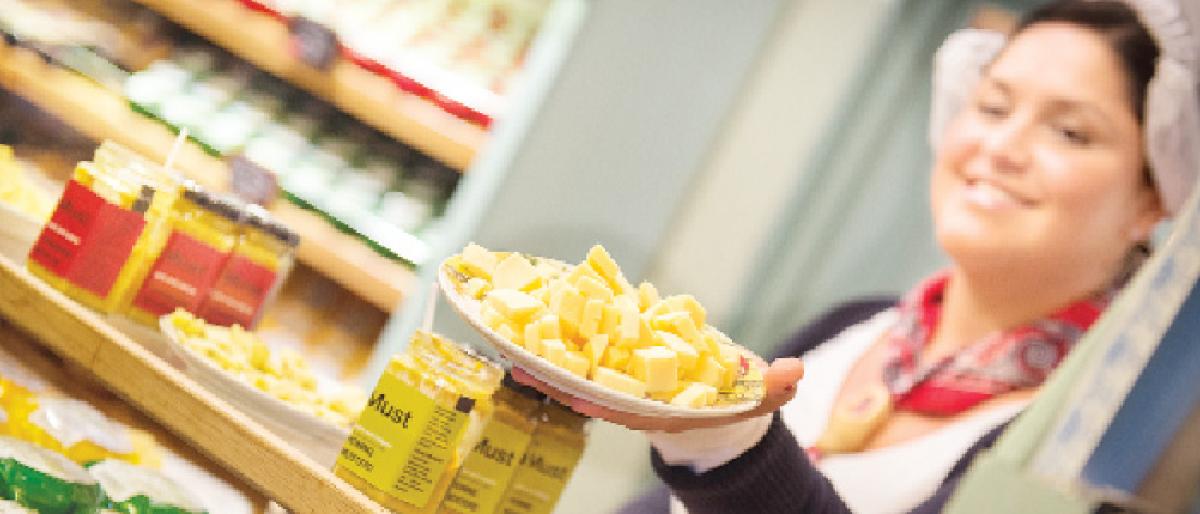Live
- DEO suspends teacher accused of sexual assault
- PM ‘cursing’ Congress out of despair: Maharashtra Cong Chief
- Applications are invited for Junior Colleges Scheme District Scheduled Castes Development Officer Ramlal
- A nomination was filed on the second day for the Nagar Kurnool parliamentary seat
- SP Gaikwad inspected the Telangana Amarnath Saleswaram Jatara yatra arrangements
- Rahul Gandhi's decision to contest from Wayanad shows 'lack of confidence': BJP President Nadda
- IPL 2024: Delhi bowlers will go after all of SRH’s top-order batters, says head coach Ricky Ponting
- At Amroha rally, PM Modi sends out ‘meaningful’ message for Muslims and Hindus
- Tripura records highest 79.83 pc voter turnout in Northeast
- The government has to clear the confusion
Just In

India and Holland have something in common: it is the love for the gold! While our love is for real 24-carat gold, theirs is for the golden yellow Gouda cheese! In Holland, there are cheese museums, exclusive cheese markets, and cheese tours for the tourists.
India and Holland have something in common: it is the love for the gold! While our love is for real 24-carat gold, theirs is for the golden yellow Gouda cheese! In Holland, there are cheese museums, exclusive cheese markets, and cheese tours for the tourists. Across the Netherlands, there are cheese trails too! It is no secret that the Dutch love their cheese and eat about seven pounds of it annually per person. The inference is cheese plays a great role in the Dutch man’s life, just as the yellow gold does in many an Indian woman’s life.
Gouda is a golden yellow Dutch cheese made from cow's milk. The cheese is named after the city of Gouda in the Netherlands. It is a semi-hard cheese popular for its rich, unique flavour and smooth texture. It is made from pasteurised cow's milk but some varieties are also are made from sheep or goat's milk. The Dutch Gouda is the most exported cheese of Holland followed by Edam cheese, which hails from Edam province of North Holland.
Catharina Hoeve in Zaanse Schans
During my recent visit to Holland, we visited Catherina Hoeve, an authentic 17th-century cheese farm, located in the Zaanse Schans area (the Dutch windmill village close to Amsterdam). Here the atmosphere of the 18th and 19th century is brought to life with fully operating windmills, museums and different arts and crafts. Protected by the chilly winds outside, we sat in the warm farmhouse to learn all about the Dutch cheese. A lady dressed in traditional costume demonstrated how Gouda cheese is made and what it is all about.
Considered one of the best in the world, the widely available golden yellow Gouda Cheese has a unique aroma and sweetness that enhances with the ageing of the cheese. The recorded history of Gouda cheese dates back to 1184, making it the oldest cheese of mankind that is still in production using its original recipe.
The name “Gouda Cheese” is derived from the city of Gouda where cheesemakers from the South of Holland gathered regularly and traded their goods with the rest of the country, as the rulers of the city were granted sole trading rights on all cheese sales in the area. This law pushed the creation of cheese making families and cheese guilds that excelled in cheese production.
The most common cheese form was a large cake weighing about 160 kg, which was sold in the market and delivered to the homes of the purchasers by the cheese-porters. Women mostly produced the cheese, but in the last 100 years, most of the Gouda cheese production was moved to the industrial facilities. Even after 800 years in the market, Gouda cheese is partly produced manually: about 300 farmers produce traditional “Boerenkaas” recipe from unpasteurised milk, aka Farmers Cheese and sold in Gouda city market each Thursday morning.
Usage
Young Gouda goes best with beer whereas aged Gouda complements wines with deep, rich flavours. It can be shredded, grated, sliced, cubed or melted and used as a table cheese or a dessert cheese. It is usually cut into slices and generally eaten with bread or crackers. Though much creamier, it has a sharply pungent taste compared to Cheddar or Edam cheese. Another popular variety Dutch Gouda cheese is the Leiden cheese. As it ages, Gouda gets harder and difficult to slice. Smoked Gouda varieties are also popular and high in demand. Like any cheese, Gouda cheese is a good source of protein, calcium and phosphorus. However, it is low in sugar, high in cholesterol and saturated fat.
The Cheese Lady quickly showed us the process of making Gouda cheese at home. Of course, she had everything ready, each stage of the cheese making:
The milk is cultured and heated. This is done till the curd and whey are separate. A portion of whey is drained and some water is added to this. The curds are then transferred into circular moulds. This is the reason behind the shape of the Gouda.
After this, the cheese is soaked in a brine solution.
Then a systematic drying takes place followed by paraffin coating and ageing.
I watched her demo with interest, admired her dress, loved her cap, appreciated her smile, and decided never to try the recipe at home. Who will toil for hours when it’s available readily? Leave the cheese making to the cheesemakers- just sit back and enjoy! All that you have to do is, take a ‘selfie’ with a huge cheese wheel in hand, a ‘cheese’ smile on the lips and post the pic on the social media.
That’s what I did, after tasting a large selection of cheeses; I bought the golden Gouda to take home.
By: Vijaya Pratap

© 2024 Hyderabad Media House Limited/The Hans India. All rights reserved. Powered by hocalwire.com







